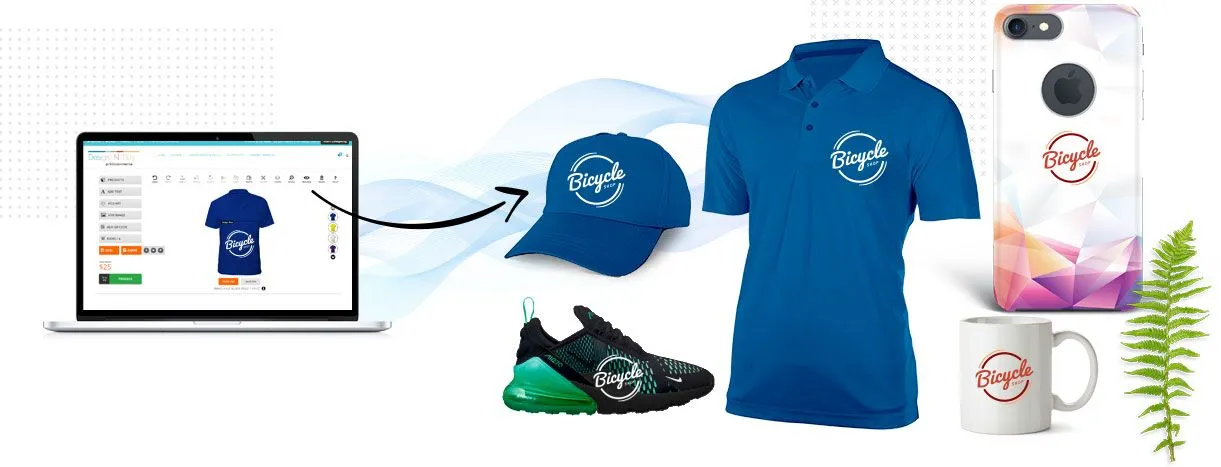Are you interested in selling custom printed t-shirts online? It may sound easy, but there’s a lot that can go wrong if you haven’t fully prepared an effective online store. To ensure the success of your t-shirt printing website, cater to customers every step of the way. Follow our top tips for success below!
5 Helpful Tips for Selling Printed T-Shirts Online
1. Create T-Shirt Designs
Although you’ll likely have personalization options available, you should also have pre-made designs available for customers to purchase. These should land within a specific niche that you’re targeting with your business. Are you making shirts for sports teams, business events, or even non-profit organizations?
However, even for your blank canvas t-shirt designs, you’ll want to have sample designs available to show what’s possible with your online store.
For both product pages and marketing materials, show examples of shirt designs as they look in your designer and on models. This can help customers get a better idea of what’s possible with your business, and even give them ideas on how they’d like to personalize their order. Show all of the different applications of your printed shirts in action.
Be sure to clearly indicate that these designs are samples when used on the product page. This can be done by including the word “sample” on the design or over the entire image as a watermark. It’s important to do this because customers may become confused and think that they are purchasing the design in the example.
2. Design Your Site with Mobile in Mind

According to research by BrizFeel, 49% of people use their mobile devices for shopping online. If your website and shirt design tools aren’t optimized for mobile, then you’ll be losing out on a huge chunk of the eCommerce market (often referred to as mCommerce).
To keep mobile shoppers from bouncing off of your site without converting, utilize responsive design. When your site is responsive, this means that it automatically changes its dimensions to fit the size of the customer’s screen. This keeps all of the important elements present on the site, maintaining usability.
Keep in mind that photos and images on your site also need to be easily viewed by mobile customers. To do this, add a zoom functionality to product photos so that customers can get up close to the shirts you’re selling. This is especially important for apparel items due to the fact that certain fabric can feel different, but only upon closer inspection can some customers determine the fabric used.
3. Give Customers Unlimited Variants
As with any other personalized product, customers want as many options available to them when personalizing their order. For each shirt on your store, you’ll want to offer your customers as many variants as possible. This includes varying sizes, colors, materials, printing areas, and more.
Each variant that you offer should also be priced appropriately. Naturally, certain materials or printing requests may cost more for your business or supplier to produce. Therefore, you should offer those options on product pages at an additional cost. This cost should be clearly marked, and the price should be updated on the product page in real-time, so that customers aren’t confronted with an unexpected price at checkout. According to the Baymard Institute, 60% of customers abandoned their carts during checkout due to extra costs being too high.
4. Offer Bulk Discounts & Free Shipping
Many of your customers may be ordering custom shirts from your business because they need a large amount. This could be for a business event, sports team, birthday party, or any other situation that requires a large number of personalized shirts.
Customers that order in bulk are highly valuable due to their high lifetime value – more likely than not, they’ll be coming back to your online t-shirt business for more if they were satisfied with their experience.
To encourage bulk orders, offer discounts based on order volume. This works by setting a threshold for either the order value or number of products in the order; once the customer has reached that threshold, they can receive the discount. This discount can either be applied automatically within your store or be applied with a coupon code that you provide to customers.
Another popular discount, especially for bulk orders, is free shipping. Due to Amazon’s popularization of free shipping, customers have come to expect that option from online stores (even if it’s difficult for your business to offer without losing money).
To offer free shipping without hurting your bottom line, you can follow the same process as the bulk order discount: utilize a free shipping threshold that customers need to meet in order to receive the discount. This ensures that the only customers receiving free shipping are those with high-value orders, indicating profit that can make up for the shipping cost.
5. Use the Right Web2Print Solution

Rather than manually processing each personalized order, sending out quotes to each customer, and designing each shirt request yourself, you can integrate with a Web2Print solution that automates this all for you. For example, DesignNBuy’s t-shirt printing software provides your online store with Web2Print functionality. This includes several features, such as:
- Design Studio for desktop with pre-loaded clipart, fonts, designs and templates, a 2D and 3D preview, an easily branded interface, etc.
- Design Studio for mobile with friendly mobile UI, image importing on the go, a zoom feature, etc.
- Web-to-Print admin panel with product personalization configuration, printing method management, etc.
Once you’ve determined which Web2Print solution you’d like to use, you’ll need to integrate it with the eCommerce platform of your choice. DesignNBuy’s solution integrates with most popular eCommerce platforms, such as Shopify, WooCommerce, and Magento.
How to Create a T-Shirt Printing Website
1. Choose Your eCommerce Website Builder
The first step to creating a website is deciding which platform you’d like to build it on. There are two main types of website builders available: hosted and open source.
Hosted eCommerce platforms, like 3dcart, are SaaS (software as a service) platforms that you pay for monthly. In exchange, you’ll receive access to the platform’s software, hosting, website builder, and any other included features.
Open source eCommerce platforms, like Magento or PrestaShop, is typically software that you download and install onto a server yourself. While you have more control over how you customize the platform, you’ll need to pay any expenses yourself, such as domain name registration, hosting, security, and maintenance.
No matter which platform you choose, you’ll need to make sure that it integrates with your Web2Print solution or print-on-demand dropshipping service.
2. Design Your Online Store
If your chosen eCommerce platform provides a built-in website builder, then you can utilize those tools to build and customize your online store. Most platforms have pre-designed themes available, which you can select from and customize to your own brand specifications.
Alternatively, you can design your website from scratch with code. If you’re not a coding professional, you may need to utilize a web design and development service.
When designing your site, keep a few things in mind:
- Utilize responsive design for mobile shoppers.
- Stay consistent across your site with your brand colors, fonts, and other design elements.
- Design with simplicity and usability in mind; don’t crowd your pages with too many distracting elements.
- Use high-quality product images for both product pages and marketing materials on your site, such as your home-page banner.
3. Add Your Products

With the design of your site finished, next is the actual products you’ll be selling. You can either upload each product manually or upload them in bulk using CSV file imports. Add both your pre-designed shirt products and your blank, customizable shirts into your store.
Each product should have a title, description, price, sizes, images, stock level, and any other important information that pertains to the product. Create categories that apply to your products and organize them into those categories in a way that makes navigation easy for your customers.
4. Create Important Pages
Your online store isn’t just about your products. To keep customers satisfied, you need to have additional pages on your site that provide them with important information. This includes a Contact Us page, an About Us page, a Returns Policy page, and more. These pages also serve to improve a potential customer’s trust in your business – without this information, a customer may be inclined to see your website as illegitimate.
If you’re interested in content marketing, you’ll also want to add blog functionality to your online store. On your store’s blog, you can create posts that provide value to your customers and your targeted niche overall.
5. Set Up Shipping & Payment Methods
With your products in place, you’ll need to add the ability for customers to purchase them. Provide several choices for customers at checkout, as different customers may prefer alternative forms of payment or shipping. In addition to the most common debit and credit card processors, you should also add the option to check out with PayPal, digital wallets, or even cryptocurrency (if your customers use it).
Customers also appreciate choices when it comes to shipping. Some customers may need faster shipping at a premium price, while others may be willing to wait longer for shipping if it means cheaper costs. Include delivery date estimates with each shipping option so that customers know how long they should expect to wait for their order. If they’re buying time-sensitive shirts for an event, this information is vital.
Wrapping Up
With all of these tips applied, you’re ready to launch a successful t-shirt printing website. The key to success is catering to your customers needs. In an industry that’s personalized, customers want to have as much control over the entire order process as possible. By giving customers power at every step, from t-shirt design to payment and shipping, they’ll keep coming back to your business for more.




